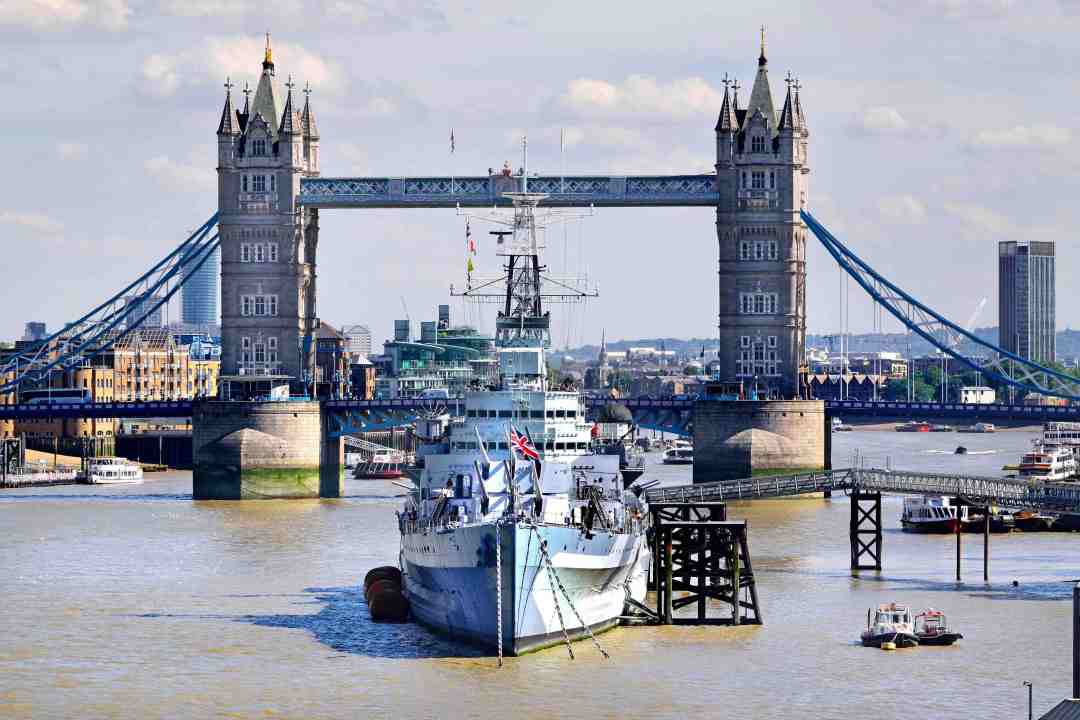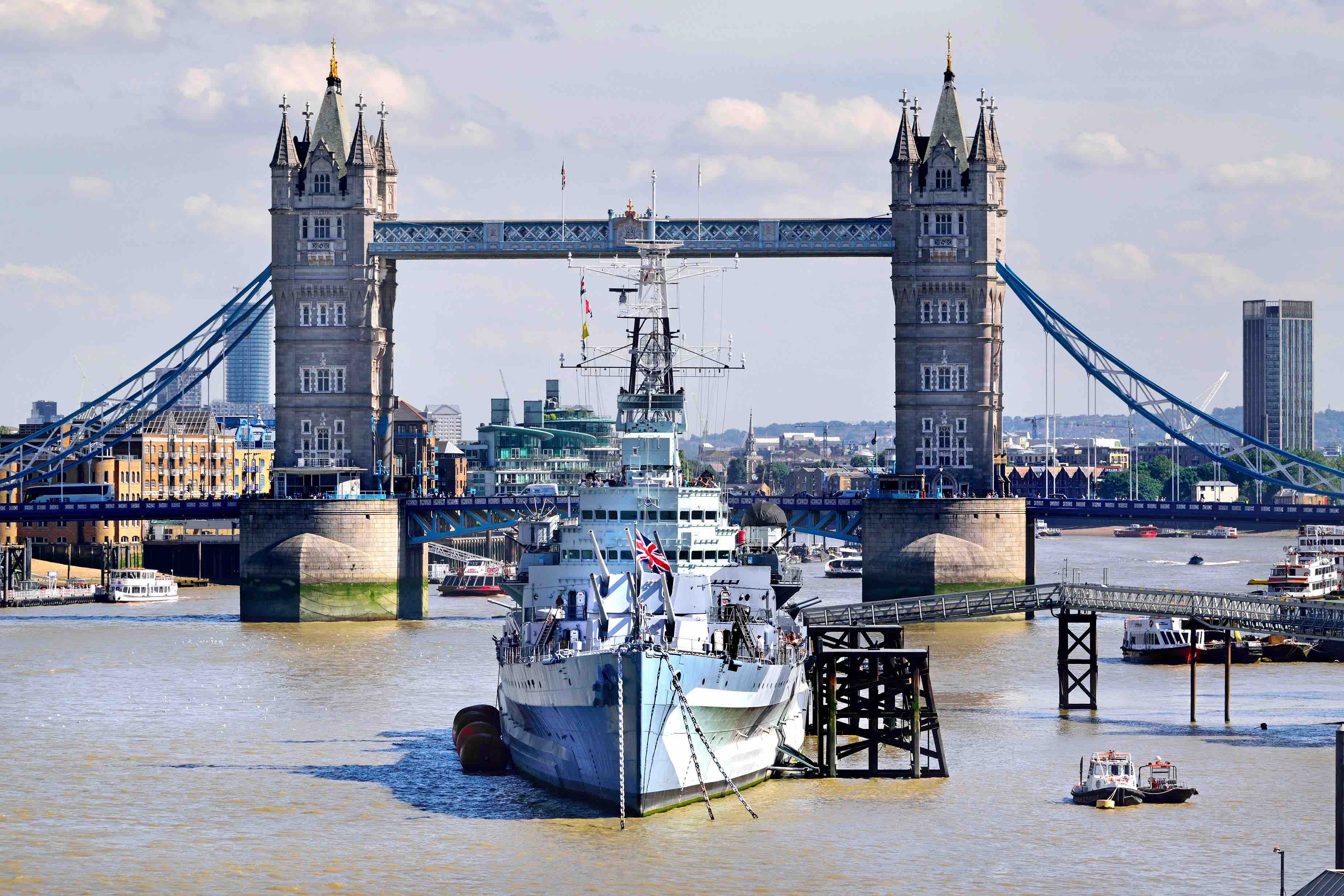On Christmas Day 1942, the German battlecruiser Scharnhorst, along with five destroyers, left its Norwegian base and headed for a series of Arctic convoys, the British fleets transporting material and support to the Soviets. The townclass cruiser HMS Belfast, used to escort the convoys through some of the most dangerous seas in the world, played a vital role in the Royal Navy’s clever game of bait-and-blast that resulted in the destruction of the Scharnhorst, a monster that had already sunk a British carrier and two destroyers. Belfast, the most powerful cruiser in the Navy at her relaunch in 1942 (she hit a mine in 1939 and needed three years of repairs), now sits in the Thames by City Hall, a visitor attraction operated by Imperial War Museums.
One recent Saturday, I visited HMS Belfast with a young man of military mindset. But it was my idea to go; he’d just as soon have sat at home vaping and watching YouTube videos about Admiral Nelson. The week before the Belfast visit, I went to the Imperial War Museum in Lambeth for the second time in several months, poring over the propaganda posters and letters from soldiers about daily life in the trenches; taking in a midget submarine and ogling a Spitfire flown in the Battle of Britain.
The truth was I fancied – indeed, increasingly fancy – the details of wars gone by, and especially, like so many others, of the first and second world war. I crave and tingle at information about weaponry, military regimen, of desperate schemes and ploys that sometimes worked; of explosions, incredible discomfort, the humdrum bits of daily routine, the fateful impact of uncontrollable variables like storms and ice and waves and miscalculated naval physics and, of course, of the heroism ordinary men and women showed entirely without premeditation. While some find belonging and focus in words like ‘solidarity’, and ‘end hate’, for me it’s words like ‘gun deck’, ‘triple turrets’, ‘radar system’, ‘provision issue room’, ‘torpedo flat’ and ‘compass platform’ that thrill, soothe and interest.
As the West is soused in a thickening hail of subjective rubbish, from identitarian abstraction to mendacious, fabricated narratives about ‘structural’ isms, war museums remind us of what actual war is; what actual enemies do
Why? Well, in the first place I’m one of those women who can’t get enough of the valour involved in killing baddies – or the macabre horror of our foes’ tactics and aspirations. Women have stocks of indignation, rage and prurience, as well as a sense for what’s just, that are as powerful, if not more so, than any man’s, making the details of war satisfying and fascinating. Indeed, I’ve noticed that the most absorbed visitors I’ve seen recently aren’t men, but young women like me, attentively browsing tanks.
There’s something magnificent too about giant hunks of transport and infrastructure. A jumbo jet up close, a Maersk container ship or a train thundering into a station make for a riveting opposite of the dull material, communicational and bureaucratic minutiae of everyday life. And with their giant noisy engines, their harnessing of physics for the very clear purpose of safe forward-movement – or destruction of enemies – they are a world away from the nebulous malignity of identity politics.
War museums – which combine such huge machines with uncompromisable facts about life-and-death contests over the fate of the whole world – are the ultimate antidote, and refuge, from the culture war. As the West is soused in a thickening hail of subjective rubbish, from identitarian abstraction to mendacious, fabricated narratives about ‘structural’ isms, all endlessly refracted through social media, war museums remind us of what actual war is; what actual enemies do.
And they illuminate the dangerous insincerity of West-bashing. In the contemporary woke mind, the imagined foe is the liberal democratic values of the Anglosphere, and acts of war are the preservation of statues of men with ties to the Empire, or the vote to leave the EU. A board game released last month in France (and subsequently taken off shelves), called Antifa: The Game, saw wannabe ‘anti-fascist’ players encouraged to throw faeces on their foes. ‘Racism, sexism, nationalism, that’s enough! Against the far-right, it’s your turn to play,’ said the box. I suspect that someone flying a Spitfire against the Germans in the second world war, steering a destroyer through enemy fire in the Arctic or hiding in the rubble of their house after a German bomb hit would struggle to understand what this meant.
Crucially, war museums are among the last public institutions to offer uncompromising relation of gritty facts – over and above those dreary, art-and-history-distorting lectures about racism and imperialism that have taken over many other museums. Just last month, the Wellcome Collection announced the withdrawal of the peerless collection of founder Henry Wellcome, which included one of Napoleon’s toothbrushes, because ‘the collection told a global story of health and medicine in which disabled people, black people, indigenous peoples and people of colour were exoticised, marginalised and exploited – or even missed out altogether’. It is end-times stuff. But unlike the icy deck of HMS Belfast under fire from German destroyers off the Norwegian coast, this is entirely of our own making.
Back to the submerged rocket systems, boiler machinery, secret radar room, chapel, kitchens, sick bay and the gun deck of HMS Belfast. Strolling about its steel-rich, pipe-stuffed, claustrophobic labyrinth, one reads not about how ‘ableist’ colonial Britain was, but about how the ship worked, of Belfast’s Rear-Admiral Robert Burnett as he chased down the Scharnhorst and how much bread was made on board. It’s bliss.
In short, if offered the choice between a talk about white privilege, a ‘discussion’ by the Wellcome curators or a chance to hear more about Robert Burnett and his ship, I know which I’d choose. And so, this week, why not take your daughters, sisters and mothers on a festive trip to HMS Belfast for an anniversary pilgrimage to admire one of Britain’s finest hours at sea – a mission in which the stakes were high and very real, the danger was enormous, the courage and plotting magnificent – and nobody had ever heard of critical race theory or intersectionality.







Comments